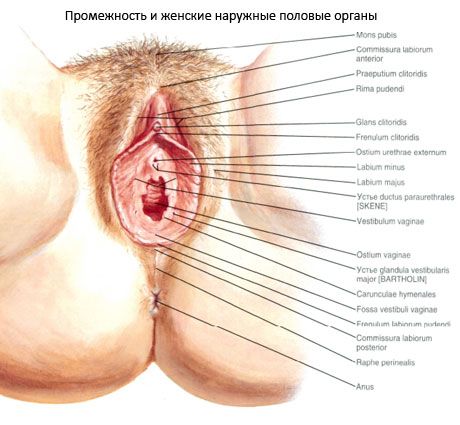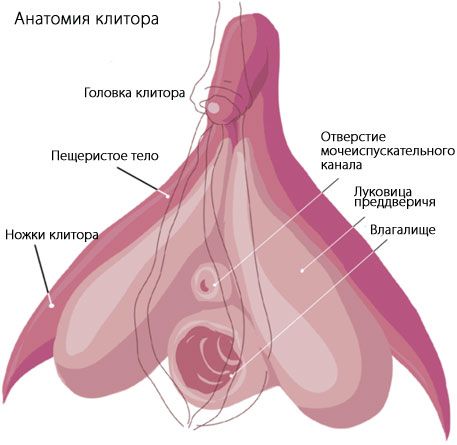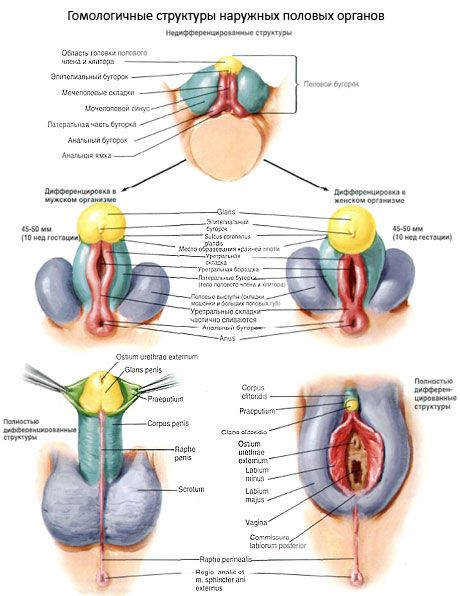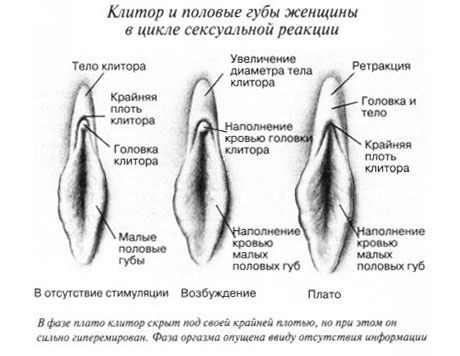Clitoris
Last reviewed: 23.04.2024

All iLive content is medically reviewed or fact checked to ensure as much factual accuracy as possible.
We have strict sourcing guidelines and only link to reputable media sites, academic research institutions and, whenever possible, medically peer reviewed studies. Note that the numbers in parentheses ([1], [2], etc.) are clickable links to these studies.
If you feel that any of our content is inaccurate, out-of-date, or otherwise questionable, please select it and press Ctrl + Enter.
Clitoris (Latin clitoris from Latin clitorido - "tickle") or outdated. Rus. The lover is an unpaired formation in the mammalian females. The homolog of the member in the males. Unlike a penis, does not include the urethra, except for the spotted hyena clitoris, which is considered a pseudo penis.
Read also:
The representatives of the weaker sex are considered the leading among the sensitive erogenous zones. It is located behind and below the front soldering of the labia majora. The clitoris is similar to the inverted Latin letter Y, somewhat compressed from the sides. The clitoris has the head (glans clitoridis), the bodies (corpus clitoridis), two cavernous bodies (corpora cavernosum clitoridis) and two legs (crura clitoridis). And also contains a large number of vessels and nerve endings.
The history of the clitoris
The history of the study of the clitoris contains a large number of "discoveries" of this structure in different countries and in different centuries. The terminology used was, among other things, different. Hippocrates used the term columella (a small column). Avicenna referred to the clitoris albatra or virga (rod). Abulkasis, another Arab medic, called his tentigo (tension). Real Colombo used the definition of amoris dulcedo (delicacy of love), sedes libidinis (seat of lust) and "fly of Venus". Knightly scholastic Albert Magnus emphasized the similarity between male and female sexual organs, using the term virga to denote male and female genitalia. The ancient Romans used the outrageous word landīca to designate the clitoris.
Regnier de Graaf insisted that we should distinguish the nymph from the clitoris, so he proposed to call this anatomical structure only a clitoris. Since the 17th century this name has become universally recognized, the nymphs at first called the vulva, and later small labia. The Greek word κλειτορίς, is quite likely to come from "tickling", although it can also mean, among other things, a "small hill"; in other words, the ancient authors had the opportunity to use the play of words. The linguist Marcel Cohen devoted a chapter in the book to the study of the appearance of the word "clitoris", although he did not come to certain conclusions.
Opening of the clitoris
The opening of the clitoris is often associated with Real Colombo - the Italian anatomist of the 16th century. In 1559 he published the work "De anatomica", in which he described "a woman's place of pleasure in sexual intercourse" and called himself the pioneer of the clitoris. Colombo wrote:
Since no one has described these processes and their functionality, and if it is possible to give the name to the organs found by me, it is necessary to call it love or Venus' sweetness ...
Colombo, among other things, mentioned the clitoris in the section on rare anatomical structures - he described an Ethiopian woman whose clitoris was the size of a pinkie, and the vaginal opening was rather narrow.
Andreas Vesalius - a friend and mentor of Colombo, whose relationship was later ruined - did not recognize this discovery. Vesalius thought that the female genitalia is a symmetrical representation of the male sexual organs. Following this doctrine, the penis was placed in accordance with the vagina, and the clitoris was never able to find a suitable male organ. Protesting against the thoughts of Colombo, Vesalius wrote:
It makes no sense to blame others for incompetence on the basis of the fun of nature that you could observe in some of the fairer sex, and you will not be able to identify this new and useless part in healthy women. I believe that this structure is most often found in hermaphrodites, which have pronounced genital organs, as described by Pavel Aeginsky, although I have never seen a single lady member (who called Avicenna an albarate, and the Greeks called the clitoris an enlarged nymph and classified as a disease ) or even the rudiment of the smallest phallus.
The dominance of Colombo in the opening of the clitoris was challenged by his successor, Gabriel Faloppio, who considered himself the pioneer of the clitoris. In his own work, Observations anatomicae, which was written in the 1550s and published in 1561, it was also suggested that this part of the female anatomy is so difficult to discover that he was the first to discover it; The rest reported on the clitoris or with his words, or with the words of his students.
Caspar Bartolin, an anatomist of the 17th century, rejected both claims, claiming that the clitoris was widely known to medical science from the 2nd century on. Prior to Colombo, the clitoris was also described by Arab, Ancient Greek and Persian physicians, although its function was mistaken. French anatomist Charles Estien in the publication of 1545 "De Dissectione Partium Corporis Humani" ascribed to the clitoris the function of urination. It is likely Colombo was the first who described the sexual function of the clitoris, but even this is disputed. The Italian philosopher and doctor of medicine Pietro d'Abano in the book Conciliator differentiarum philosophorum et medicorum wrote that the friction of the upper orifice within the pubic area causes excitement in the fairer sex, although it did not analyze the detailed anatomy of the clitoris.

Structure of the clitoris
Coglasno Research Australian urologist Helen O'Connell clitoris has two of the cavernous body (corpus cavernosum clitoridis), head of the clitoris (lat. Glans clitoridis), clitoral legs (lat. Crus clitoridis) and two bulbs of the vestibule of the vagina (in other clitoral bulbs) ( bulbus vestibuli vaginae). Fibrous membranes that surround the cavernous halves of the body of the clitoris, converge above the median surfaces, and form a septum, to which elastic and smooth muscle fibers are attached.

The cavernous body of the clitoris divides over the urethra into two legs, enveloping the urethra and the vagina on both sides, and terminate in the form of two bulbs, forming the clitoro-retrovaginal complex. The body of the clitoris is connected to the ischial-pubic branch (ramus ischiopubicus) by the root, while two small ischoconstrinocephalic muscles (musculus ischiocavernosus) are attached to the legs in the inner part of the head and cavernous bodies of the clitoris, and form a complex of nerve endings. Blood supply to the clitoris is carried out by the branches of the internal pudendal artery (arteria pudenda interna). In the visible part of the clitoris, there are three key areas: the head, the frenum of the clitoris and the clitoral hood. Anatomically, the clitoris corresponds to the male penis.

Clitoris head
The head of the clitoris (glans clitoridis) is the most sensitive part of the woman's body, it has many blood vessels and nerve endings. At some representatives of a weaker sex the head is so sensitive, that its direct stimulation (at a masturbation or cunnilingus) can cause unpleasant sensations. The head of the clitoris is covered with a skin fold (the so-called clitoral hood), or the foreskin. In a calm state, the head of the clitoris either is not noticeable at all, or only a small part of it is visible. With sexual arousal, an erection of the clitoris is observed, and the head protrudes forward.
Clitoral feces
Clitoral frenum is a fold of the skin that unites the front ends of the labia minora and the lower surface of the clitoris (frenulum clitoridis)
Clitoral hood
The clitoral hood (Latin preputium clitoridis) is usually noticeable during gynecological examination, but in some women who have puffy large labia, the clitoris is not noticeable.
The most famous place for women's intimate piercing. First of all, when talking about a punctured clitoris, it is exactly the horizontal puncture of the clitoral hood, beautifully decorated with a ringlet, barbellum, microbane and others. Puncture of the clitoris is considered one of the most difficult and is likely only in the case of biocompatibility with this type of piercing (a small, badly discernible clitoris can not be pierced).
Clitoris during intercourse
In most women, the clitoris is considered the main erogenous zone. It is for this reason that the clitoris is considered the main source of pleasant sensations that a woman experiences during sexual intercourse. At the same time, as a result of the distinctive features of female anatomy, when a vaginal intercourse is involved, the male member does not directly affect the clitoris, since the movements of the male organ occur in the vagina, and there is no direct action directly on the clitoris.
Stimulation of the clitoris during sexual intercourse occurs indirectly through the adjacent parts of the female genital organs, for example, by pulling and twitching the labia minora. Traditionally, this is enough to increase excitement and achieve orgasm, although in some cases, women resort to additional stimulation of the clitoris with their fingers.

In most cases, the clitoris is not excited immediately. This is evident from the absence of secretory fluid, which is released from the female genitalia. Usually, sexual arousal is accompanied by an abundant secretion of secretory fluid from the vagina. Shortly before reaching orgasm, the clitoris slightly decreases in size. This partly protects its receptive part from subsequent stimuli. But, there are some doubts that this is the case. At the moment of orgasm rhythmic contractions of muscles occur in the outer third of the genital organs and in the uterus. They occur initially approximately every 0.8 seconds, then become less intense and more chaotically separate, as the orgasm continues. Orgasm can have a different number of muscle contractions, based on intensity.
Immediately after orgasm, the clitoris can be so sensitive that each stimulation can cause discomfort.
In some women, with a sexual stimulation, the clitoris can be approximately doubled, while in others it almost does not change its size. Unlike the erection of the penis in men, the reaction of the clitoris to the sexual stimulus is manifested only after 20-30 seconds after the onset of action.
With prolonged intense excitation, the head of the clitoris can be almost completely hidden in the folds of the labia minora. Shortly before orgasm, the clitoris decreases approximately half. After 5-10 seconds after orgasm the clitoris returns to its normal size.
Clitoris dimensions
In most human communities, the size of the clitoris was not considered significant. But the inhabitants of Easter Island approved a large clitoris, and some tried with varying degrees of success to increase the clitoris of their girls.
Theo Lang recalls an Internet registered case when the lady's head was 5 centimeters long and reached 7.5 centimeters, "when the clitoris was in a state of full erection." Ralph Pomeroy noted that in white women, the size of the clitoral head is more than 2.5 centimeters in length, although they occur in 2-3% of blacks - "sizes of 7.5 centimeters or more are detected in approximately 300 or 400 blacks women ".
Another author notes that Paran-Dushatel met a woman whose head of the clitoris was 8 cm long. The Swiss biologist of the XVIII century Albrecht von Galler stated that he met a woman with a giant clitoris not less than 18 centimeters in length. The record length of the clitoris, mentioned by various authors, is 30 centimeters.
The dimensions of the clitoris and its heads are individual: the total length of the head is from 5 mm to 1 cm, diameter from 2 to 20 mm. The total length of the clitoris is traditionally from 8 to 20 centimeters.
Contrary to the established opinion, the size of the clitoris is absolutely unrelated to the degree of sexual arousal a woman can experience.
The clitoris and its size are in no way related to the age, even with the period of menopause and after it. Of the women who gave birth to the fairer sex, in most cases, the clitoris measurements show slightly larger mean values of the size of the clitoris


 [
[